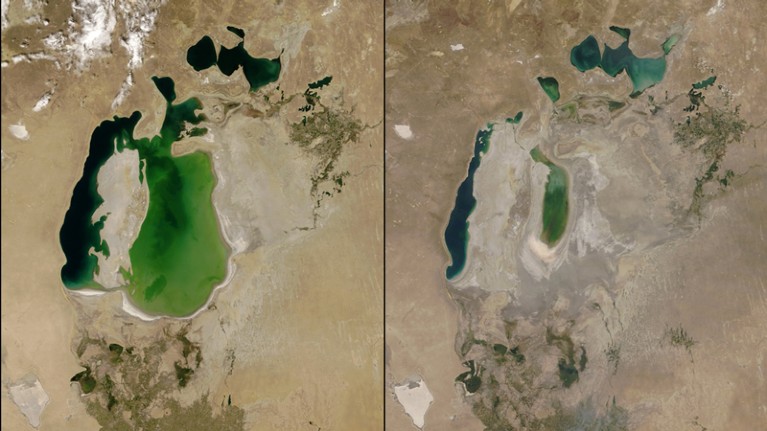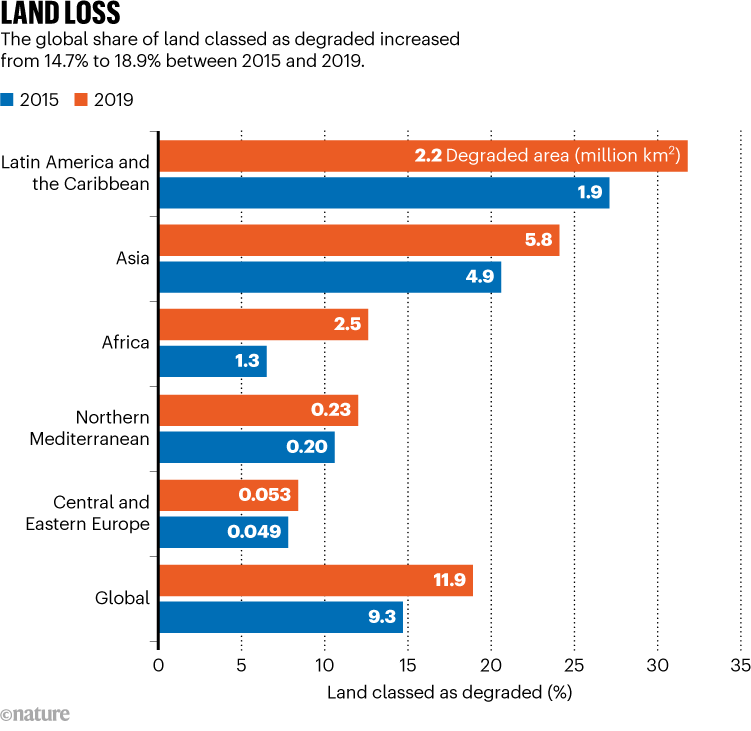
The Aral Sea, on the border between Uzbekistan and Kazakhstan, almost completely dried up between 2000 (left) and 2018 (right).Credit: NASA
Last week, Samarkand in Uzbekistan hosted an important intergovernmental conference on how to halt the creeping spread of degraded land. The country was aptly chosen: only about 800 kilometres from the meeting, the Aral Sea spans the border between Uzbekistan and Kazakhstan. Once the world’s fourth-largest lake, it has almost completely dried up because of excessive extraction of water for irrigation during the twentieth century. Its exposed, highly polluted lake bed is a large source of blinding sandstorms and emits more than 100 million tonnes of dust and toxic chemicals every year.
Between 2015 and 2019, the world lost at least 100 million hectares of healthy and productive land a year, according to an analysis for the United Nations Convention to Combat Desertification (UNCCD), which organized the meeting. Human activities — including deforestation and agricultural practices — and climate change are among the main causes.
As part of tracking progress towards the 15th UN Sustainable Development Goal, ‘life on land’, 115 countries reported ahead of the meeting on three measures for restoring degraded land and soil (see go.nature.com/3sqzxm2): the area used for agriculture or covered by forests, grassland or wetlands; productivity, the ability of land to support and sustain life; and above- and below-ground stocks of carbon. Reaching the target of ‘land degradation neutrality’ by 2030 means reversing a negative trend. The global share of land that is degraded increased from 14.7% in 2015 to 18.9% in 2019 (see ‘Land loss’), the last year for which comprehensive data were available. In Mexico, more than 71.9% of land was classed as degraded in 2019, up from 56.7% in 2015. During the same period, India’s fraction of degraded land more than doubled to 9.5%. And many countries in Africa reported considerable increases — in Ethiopia, Madagascar, Mauritania, Eritrea and Somalia, the area of degraded land was between two and eight times larger in 2019 than in 2015.

Yet there are some important signs of hope amid a mostly bleak outlook. The analysis enables countries to understand land degradation at a more-granular level than before. And the UNCCD’s science teams did not perform the study: they helped to train researchers in some of the most-affected countries, so that local scientists and policymakers could do the work themselves, including monitoring progress on a continuous basis, using open sources.
This work is crucial for altering course. And some countries are moving in the right direction. In Ecuador, for example, the area of land classed as degraded went from 21.9% to 12.8% between 2015 and 2019. During the same period, the degraded area in Botswana decreased from 36.3% to 17.1%, and in Burkina Faso from 34.6% to 8.2%. In Africa, Latin America and the Caribbean, improvements are made mainly by restoring tree cover; in Asia, gains also came from improvements in soil fertility.
Land degradation is not a priority on the world’s environmental agenda. Although the UNCCD has the same status as the UN conventions on climate change and biodiversity, unlike them it does not have an autonomous body that provides independent scientific advice. Restoration projects also receive much less international funding — they attracted around US$5 billion between 2015 and 2019 — than do climate projects, which have yearly funds of close to $100 billion, and biodiversity programmes, which attract around $154 billion a year.
This funding disparity illustrates just how little priority is given to restoring land and preventing further degradation. Yet the latest analysis shows what can be done even with limited resources. But not all countries are providing data. These nations, especially high-income countries, should start reporting their plans and actions, to raise the profile of land degradation and help reverse the trend.

 Researchers have a rare opportunity in making progress to protect global biodiversity
Researchers have a rare opportunity in making progress to protect global biodiversity
 World leaders must step up to put biodiversity deal on path to success
World leaders must step up to put biodiversity deal on path to success
 Is Africa’s Great Green Wall project withering
Is Africa’s Great Green Wall project withering




